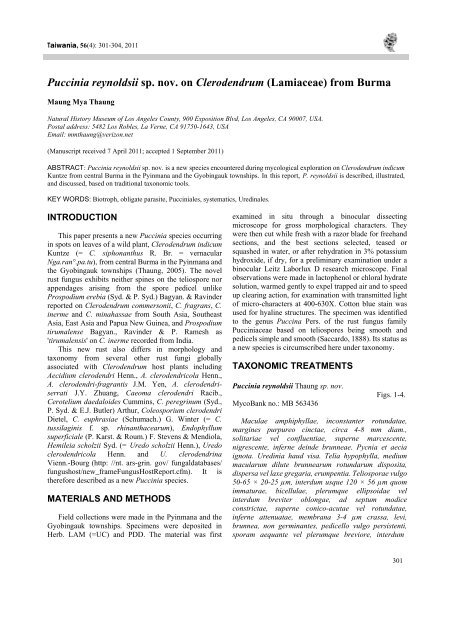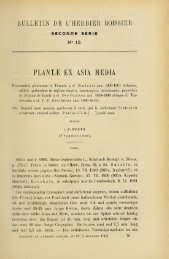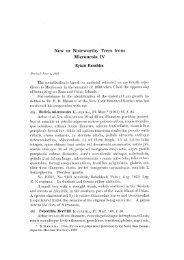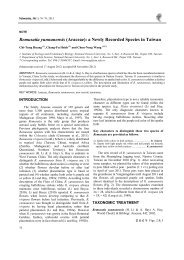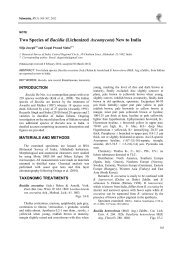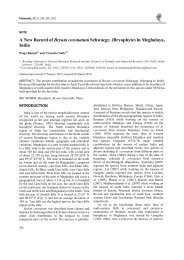Full text (PDF)
Full text (PDF)
Full text (PDF)
You also want an ePaper? Increase the reach of your titles
YUMPU automatically turns print PDFs into web optimized ePapers that Google loves.
Taiwania, 56(4): 301-304, 2011<br />
Puccinia reynoldsii sp. nov. on Clerodendrum (Lamiaceae) from Burma<br />
Maung Mya Thaung<br />
Natural History Museum of Los Angeles County, 900 Exposition Blvd, Los Angeles, CA 90007, USA.<br />
Postal address: 5482 Los Robles, La Verne, CA 91750-1643, USA<br />
Email: mmthaung@verizon.net<br />
(Manuscript received 7 April 2011; accepted 1 September 2011)<br />
ABSTRACT: Puccinia reynoldsii sp. nov. is a new species encountered during mycological exploration on Clerodendrum indicum<br />
Kuntze from central Burma in the Pyinmana and the Gyobingauk townships. In this report, P. reynoldsii is described, illustrated,<br />
and discussed, based on traditional taxonomic tools.<br />
KEY WORDS: Biotroph, obligate parasite, Pucciniales, systematics, Uredinales.<br />
INTRODUCTION<br />
This paper presents a new Puccinia species occurring<br />
in spots on leaves of a wild plant, Clerodendrum indicum<br />
Kuntze (= C. siphonanthus R. Br. = vernacular<br />
Nga.ran°.pa.tu), from central Burma in the Pyinmana and<br />
the Gyobingauk townships (Thaung, 2005). The novel<br />
rust fungus exhibits neither spines on the teliospore nor<br />
appendages arising from the spore pedicel unlike<br />
Prospodium erebia (Syd. & P. Syd.) Bagyan. & Ravinder<br />
reported on Clerodendrum commersonii, C. fragrans, C.<br />
inerme and C. minahassae from South Asia, Southeast<br />
Asia, East Asia and Papua New Guinea, and Prospodium<br />
tirumalense Bagyan., Ravinder & P. Ramesh as<br />
'tirumalensis' on C. inerme recorded from India.<br />
This new rust also differs in morphology and<br />
taxonomy from several other rust fungi globally<br />
associated with Clerodendrum host plants including<br />
Aecidium clerodendri Henn., A. clerodendricola Henn.,<br />
A. clerodendri-fragrantis J.M. Yen, A. clerodendri-<br />
serrati J.Y. Zhuang, Caeoma clerodendri Racib.,<br />
Cerotelium daedaloides Cummins, C. peregrinum (Syd.,<br />
P. Syd. & E.J. Butler) Arthur, Coleosporium clerodendri<br />
Dietel, C. euphrasiae (Schumach.) G. Winter (= C.<br />
tussilaginis f. sp. rhinanthacearum), Endophyllum<br />
superficiale (P. Karst. & Roum.) F. Stevens & Mendiola,<br />
Hemileia scholzii Syd. (= Uredo scholzii Henn.), Uredo<br />
clerodendricola Henn. and U. clerodendrina<br />
Vienn.-Bourg (http: //nt. ars-grin. gov/ fungaldatabases/<br />
fungushost/new_frameFungusHostReport.cfm). It is<br />
therefore described as a new Puccinia species.<br />
MATERIALS AND METHODS<br />
Field collections were made in the Pyinmana and the<br />
Gyobingauk townships. Specimens were deposited in<br />
Herb. LAM (=UC) and PDD. The material was first<br />
examined in situ through a binocular dissecting<br />
microscope for gross morphological characters. They<br />
were then cut while fresh with a razor blade for freehand<br />
sections, and the best sections selected, teased or<br />
squashed in water, or after rehydration in 3% potassium<br />
hydroxide, if dry, for a preliminary examination under a<br />
binocular Leitz Laborlux D research microscope. Final<br />
observations were made in lactophenol or chloral hydrate<br />
solution, warmed gently to expel trapped air and to speed<br />
up clearing action, for examination with transmitted light<br />
of micro-characters at 400-630X. Cotton blue stain was<br />
used for hyaline structures. The specimen was identified<br />
to the genus Puccina Pers. of the rust fungus family<br />
Pucciniaceae based on teliospores being smooth and<br />
pedicels simple and smooth (Saccardo, 1888). Its status as<br />
a new species is circumscribed here under taxonomy.<br />
TAXONOMIC TREATMENTS<br />
Puccinia reynoldsii Thaung sp. nov.<br />
MycoBank no.: MB 563436<br />
Figs. 1-4.<br />
Maculae amphiphyllae, inconstanter rotundatae,<br />
margines purpureo cinctae, circa 4-8 mm diam.,<br />
solitariae vel confluentiae, superne marcescente,<br />
nigrescente, inferne deinde brunneae. Pycnia et aecia<br />
ignota. Uredinia haud visa. Telia hypophylla, medium<br />
macularum dilute brunnearum rotundarum disposita,<br />
dispersa vel laxe gregaria, erumpentia. Teliosporae vulgo<br />
50-65 × 20-25 µm, interdum usque 120 × 56 µm quom<br />
immaturae, bicellulae, plerumque ellipsoidae vel<br />
interdum breviter oblongae, ad septum modice<br />
constrictae, superne conico-acutae vel rotundatae,<br />
inferne attenuatae, membrana 3-4 µm crassa, levi,<br />
brunnea, non germinantes, pedicello vulgo persistenti,<br />
sporam aequante vel plerumque breviore, interdum<br />
301
302<br />
Taiwania Vol. 56, No. 4<br />
Fig. 1. Clerodendrum indicum Kuntze leaves with subglobose spots of rust. Bar = 1.5 cm.<br />
Fig. 2. Puccinia reynoldsii – Telium with young teliospores. Bar = 30 µm.
December, 2011 Thaung: A new Puccinia species in Burma<br />
Fig. 3. Puccinia reynoldsii – Young developing teliospores.<br />
Bar = 30 µm<br />
oblique affixo, attenuato, simplici, hyalino; mesosporae<br />
25-30 × 20-25 µm, unicellulae.<br />
Holotypus: BURMA, Pyinmana, on leaves of<br />
Clerodendrum indicum Kuntze (Lamiaceae), 13 Dec<br />
1977, leg. et det. Maung Mya Thaung (LAM (=UC)<br />
220424-III-holotypus, PDD 56247-III-isotypus);<br />
BURMA, Gyobingauk, on leaves of Clerodendrum sp.<br />
(Lamiaceae), 18 Dec 1977, leg. et det. Maung Mya<br />
Thaung (LAM (=UC) 220978-III-paratypus).<br />
Spots on both sides of leaf, subglobose, pinkish to<br />
purplish at margin, about 4-8 mm diam, separate or<br />
coalescing, fading to dark grey above, becoming brown<br />
below (Fig. 1). Pycnia and aecia unknown. Uredinia not<br />
seen. Telia hypophyllous, dispersed or loosely grouped,<br />
becoming erumpent. Teliospores generally 50-65 ×<br />
20-25 µm, sometimes up to 120 × 56 µm when<br />
immature, 2-celled, mostly ellipsoid or occasionally<br />
short-oblong, moderately constricted at septum,<br />
conic-acute to round above, attenuate below, wall 3-4<br />
µm thick, smooth, brown, not germinating, pedicel<br />
commonly persistent, equal to spore in length or<br />
generally shorter, sometimes obliquely attached,<br />
attenuate, simple, hyaline; mesospores 25-30 × 20-25<br />
µm, 1-celled (Figs. 2-4).<br />
Etymology: Named after Dr Don R. Reynolds,<br />
Research Botanist, Herbarium, University of California,<br />
Berkeley, for his enthusiastic support for the study of<br />
fungi from Burma.<br />
DISCUSSION<br />
Puccinia reynoldsii sp. nov. produces mesospores<br />
Fig. 4. Puccinia reynoldsii – Teliospores and mesospores.<br />
Bar = 30 µm.<br />
just like Prospodium tirumalense, but differs from<br />
Prospodium erebia and P. tirumalense in having smooth<br />
teliospores and simple, smooth pedicels. Moreover, it<br />
utilizes an entirely distinct host plant species,<br />
Clerodendrum indicum, in Lamiaceae while<br />
Prospodium rusts are geographically restricted largely<br />
to the Americas and the Caribbeans on Bignoniaceae and<br />
Verbenaceae (Cummins and Hiratsuka, 2003).<br />
LITERATURE CITED<br />
Cummins, G. B. and Y. Hiratsuka. 2003. Illustrated Genera<br />
of Rust Fungi. 3rd ed. American Phytopathological Society<br />
Press, St. Paul, MN, USA. 225pp.<br />
Saccardo, P. A. 1888. Puccinia graminis Pers. Sylloge<br />
Fungorum. 7: 622.<br />
Thaung, M. M. 2005. Rusts, smuts and their allies in Burma.<br />
Australas Mycol. 24: 29–46.<br />
USDA, A. R. S. 2011. http://nt.ars-grin.gov/fungaldatabases/<br />
fungushost/ fungushost.cfm, accessed on 4/06/11.<br />
303
304<br />
Taiwania Vol. 56, No. 4<br />
緬甸於大青屬(Clerodendrum)植物體上的新種銹菌 – Puccinia reynoldsii<br />
Maung Mya Thaung<br />
Natural History Museum of Los Angeles County, 900 Exposition Blvd, Los Angeles, CA 90007, USA.<br />
Postal address: 5482 Los Robles, La Verne, CA 91750-1643, USA.<br />
Email: mmthaung@verizon.net<br />
(收稿日期:2011 年 4 月 7 日;接受日期:2011 年 9 月 1 日)<br />
摘要:在一次真菌調查中,於中緬甸的 Pyinmana 及 the Gyobingauk 鎮,長管大青<br />
(Clerodendrum indicum Kuntze)這種植物上發現一新種銹菌 – Puccinia reynoldsii。本文提<br />
供該新種之描述、圖片並進行討論。<br />
關鍵詞:活體營養生物、絕對寄生菌、柄銹菌目、系統分類學、銹菌目。


